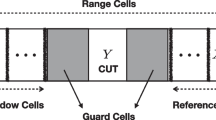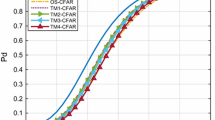Abstract
The Pareto distribution has been validated as a new clutter intensity model for X-band high resolution maritime surveillance radar returns. Consequently, corresponding detection schemes have become of much interest. This paper examines the development of constant false alarm rate radar (CFAR) detectors operating in Pareto distributed clutter. Recent developments in the literature have shown that it is possible to produce CFAR detectors for this clutter model by transforming the Gaussian intensity CFAR detectors. This results in the preservation of the Gaussian threshold multiplier/probability of false alarm relationship. The cost of doing this is that the new CFAR process depends on the Pareto clutter scale parameter. This paper examines an alternative approach to Pareto CFAR development.










Similar content being viewed by others
Explore related subjects
Discover the latest articles, news and stories from top researchers in related subjects.References
Anasstassopoulos, V., & Lampropoulos, G. A. (1995). Optimal CFAR detection in weibull clutter. IEEE Transactions on Aerospace and Electronic Systems, 31, 52–64.
Balleri, A., Nehorai, A., & Wang, J. (2007). Maximum likelihood estimation for compound-Gaussian clutter with inverse-gamma texture. IEEE Transactions on Aerospace and Electronic Systems, 43, 775–780.
Beaumont, G. P. (1980). Intermediate mathematical statistics. London: Chapman and Hall.
Farshchian, M., & Posner, F. L. (2010). The Pareto distribution for low grazing angle and high resolution X-band sea clutter. In IEEE radar conference (pp. 789–793).
Gandhi, P. P., & Kassam, S. A. (1994). Optimality of the cell averaging CFAR detector. IEEE Transactions on Information Theory, 40, 1226–1228.
Gandhi, P. P., & Kassam, S. A. (1988). Analysis of CFAR processors in nonhomogeneous background. IEEE Transactions on Aerospace and Electronic Systems, 24, 427–445.
Goldstein, G. B. (1973). False alarm regulation in log-normal and Weibull clutter. IEEE Transactions on Aerospace and Electronic Systems, AES–9, 84–92.
Levanon, N. (1988). Radar principles. New York: Wiley.
Minkler, G., & Minkler, J. (1990). CFAR: The principles of automatic radar detection in clutter. Baltimore: Magellan.
Ravid, R., & Levanon, N. (1992). Maximum-likelihood CFAR for Weibull background. IEE Proceedings F, 139, 256–264.
Sangston, K. J., Gini, F., & Greco, M. S (2010). New results on coherent radar target detection in heavy-tailed compound Gaussian clutter. In IEEE Radar Conference (pp. 779–784).
Sangston, K. J., Gini, F., & Greco, M. S. (2012). Coherent radar target detection in heavy-tailed compound Gaussian clutter. IEEE Transactions on Aerospace and Electronic Systems, 48, 64–77.
Shang, X., & Song, H. (2011). Radar detection based on compound-Gaussian model with inverse gamma texture. IET Radar, Sonar and Navigation, 5, 315–321.
Shor, M., & Levanon, N. (1991). Performance of order statistics CFAR. IEEE Transactions on Aerospace and Electronic Systems, 27, 214–224.
Stacy, N., Crisp, D., Goh, A., Badger, D., & Preiss, M. (2005). Polarimetric analysis of fine resolution X-band sea clutter data. In Proceedings of the international geoscience and remote sensing symposium (pp. 2787–2790).
Weinberg, G. V. (2011a). Assessing the Pareto fit to high resolution high grazing angle sea clutter. IET Electronics Letters, 47, 516–517.
Weinberg, G. V. (2011b). Coherent multilook radar detection for targets in Pareto distributed clutter. IET Electronics Letters, 47, 822–824.
Weinberg, G. V. (2012). Coherent multilook radar detection for targets in KK-distributed clutter. In C. Palanisamy (Ed.), Digital communication. Croatia: Intech.
Weinberg, G. V. (2013a). Constant false alarm rate detectors for Pareto clutter models. IET Radar, Sonar and Navigation, 7, 153–163.
Weinberg, G. V. (2013b). Estimation of Pareto clutter parameters using order statistics and linear regression. IET Electronics Letters, 49, 845–846.
Weinberg, G. V. (2014). Constant false alarm rate detection in Pareto distributed clutter: Further results and optimality issues. Hikari Journal of Contemporary Engineering Sciences, 7, 231–261.
Acknowledgments
The Author would like to express thanks to the three reviewers whose comments improved the paper considerably. In particular, one reviewer needs to be acknowledged for a comprehensive review of this work.
Author information
Authors and Affiliations
Corresponding author
Rights and permissions
About this article
Cite this article
Weinberg, G.V. Examination of classical detection schemes for targets in Pareto distributed clutter: do classical CFAR detectors exist, as in the Gaussian case?. Multidim Syst Sign Process 26, 599–617 (2015). https://doi.org/10.1007/s11045-013-0275-y
Received:
Revised:
Accepted:
Published:
Issue Date:
DOI: https://doi.org/10.1007/s11045-013-0275-y




